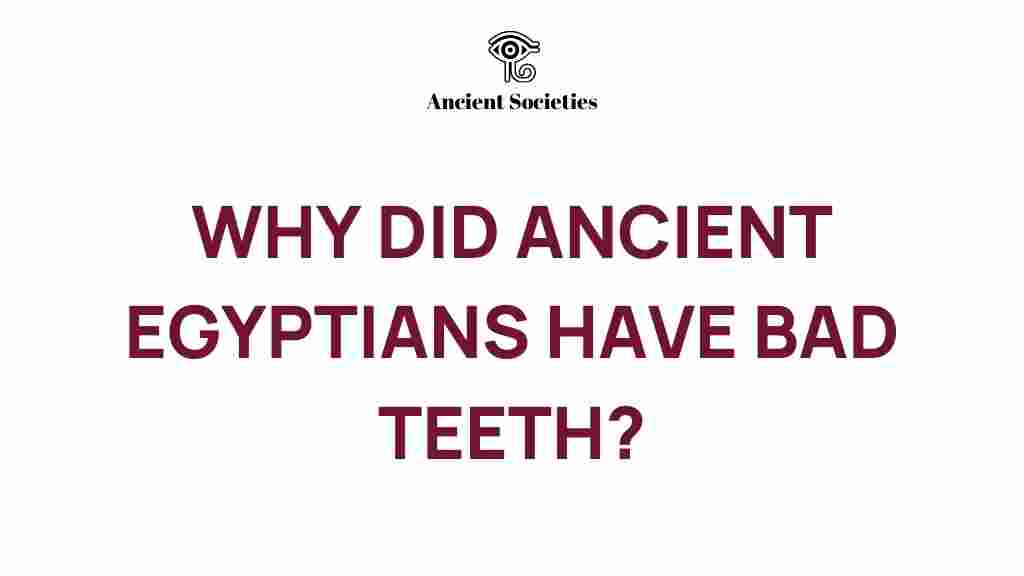Ancient Egyptians and Their Dental Health: Unveiling the Dental Dilemma
The dental health of the Ancient Egyptians has long intrigued historians, archaeologists, and health professionals alike. Despite their advanced civilization and rich culture, many Ancient Egyptians suffered from significant dental issues. This article delves into the archaeological findings, historical context, and societal habits that contributed to their dental health problems. We will explore how nutrition, health issues, and mummification practices played critical roles in shaping dental health among the Ancient Egyptians.
The Archaeological Evidence of Dental Health Issues
Archaeological studies have provided substantial evidence regarding the oral health of Ancient Egyptians. Research on mummies and skeletal remains reveals a startling prevalence of dental caries (cavities), periodontal disease, and tooth loss. Key findings include:
- High Rates of Tooth Decay: Many mummies show signs of significant decay, particularly in molars.
- Periodontal Disease: Evidence of gum disease is prevalent, with many individuals exhibiting the effects of untreated infections.
- Tooth Loss: Many remains have been found with missing teeth, indicating severe dental issues.
These findings pose the question: what went wrong in the dental health of Ancient Egyptians? To understand the dental dilemma, we must examine various factors, including their nutrition and societal habits.
Cultural and Nutritional Influences on Dental Health
The diet of Ancient Egyptians was diverse but had significant implications for their dental health. Their nutrition played a vital role in the dental issues they faced. Key components of their diet included:
- Grains: Bread made from emmer wheat was a staple food, often ground with stones, leading to grit and wear on teeth.
- Fruits and Vegetables: They consumed a variety of fruits like figs and dates, which, while healthy, are high in sugar.
- Honey: Used as a sweetener, honey contributed to high sugar consumption.
While their diet included many beneficial foods, the high carbohydrate content and the presence of abrasive materials from grinding grains contributed to dental decay and wear.
Societal Habits and Health Issues
Beyond diet, societal habits influenced dental health. The Ancient Egyptians had a unique approach to health care and hygiene:
- Lack of Oral Hygiene: While they practiced some forms of dental care, such as using sticks to clean teeth, these methods were insufficient to combat decay.
- Societal Stressors: High-stress levels, particularly among workers and laborers, may have exacerbated health issues, including dental problems.
- Health Disparities: The wealthier classes had better access to food, but they also had diets high in sugar and starch, which led to similar dental issues.
These societal habits combined with their nutritional choices created a perfect storm for poor dental health. The prevalence of dental issues can be viewed as a reflection of their cultural practices and available resources.
The Role of Mummification in Understanding Dental Health
Mummification practices in Ancient Egypt not only serve religious purposes but also provide insights into their health, particularly dental health. The process of mummification involved:
- Preservation of the Body: Mummies were often treated with resins and oils, which may have had some antibacterial properties.
- Dental Examination: Archaeologists can examine teeth during mummification to understand the extent of dental diseases.
- Burial Practices: The positioning of the body and the inclusion of dental tools in tombs suggest a cultural importance placed on oral health.
The study of mummies has revealed that dental health issues were widespread, providing a clearer picture of the struggles faced by Ancient Egyptians.
Step-by-Step: Understanding the Dental Dilemma
To truly grasp the dental dilemma faced by Ancient Egyptians, we can break down the contributing factors into a step-by-step process:
- Diet Analysis: Examine the composition of their diet, focusing on the high carbohydrate and sugar content.
- Dental Hygiene Practices: Investigate the oral hygiene practices and their effectiveness in preventing dental issues.
- Impact of Mummification: Study the preservation methods and how they relate to the health of the teeth.
- Societal Context: Consider the social and economic factors that influenced food access and health care.
This systematic approach highlights how intertwined these elements are in contributing to the dental health problems of Ancient Egyptians.
Troubleshooting Dental Health Issues in Ancient Egypt
If we were to troubleshoot the dental health issues faced by Ancient Egyptians, several strategies might be considered:
- Incorporating More Fiber: Increasing the intake of fibrous foods might have aided in naturally cleaning teeth.
- Improving Oral Hygiene: Educating the population about effective dental hygiene could have mitigated some dental issues.
- Diversifying Diet: Reducing the reliance on high-carb foods and incorporating more protein and healthy fats could have improved overall health.
- Regular Dental Check-ups: If possible, establishing practices for regular dental check-ups could help in early detection of issues.
While these solutions may seem modern, they reflect a fundamental understanding of dental health that could have benefited Ancient Egyptians.
Conclusion: Reflecting on Ancient Egyptians’ Dental Health
In conclusion, the dental health of Ancient Egyptians presents a fascinating case study that intertwines archaeology, history, and cultural practices. Their dietary choices, societal habits, and mummification methods played significant roles in shaping their dental health outcomes. Despite their remarkable achievements, the dental dilemma serves as a reminder of the complexities of health in ancient societies.
Understanding the dental health of Ancient Egyptians not only sheds light on their medical practices but also offers insights into how modern societies can learn from historical health issues. As we continue to unravel the mysteries of Ancient Egypt, their dental health remains an intriguing aspect of their rich cultural tapestry.
For further reading on the health practices of Ancient Egyptians, consider visiting this source. If you’re interested in exploring more about ancient diets and health, check out this link.
This article is in the category Archaeology and created by AncientSocieties Team
